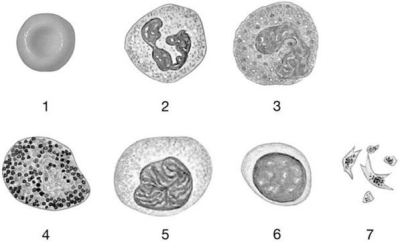A) blood type.
B) clotting factors.
C) formed elements abundance.
D) plasma composition.
E) sedimentation rate.
Correct Answer

verified
Correct Answer
verified
Multiple Choice
All of the following are functions of blood except
A) regulating pH.
B) transporting gases and hormones.
C) generating action potentials.
D) defending against pathogens.
E) regulating ion concentration.
Correct Answer

verified
Correct Answer
verified
Multiple Choice
Excess iron is stored in the liver and spleen as
A) transferrin.
B) urobilin and stercobilin.
C) bilirubin and biliverdin.
D) hemoglobin.
E) hemosiderin and ferritin.
Correct Answer

verified
Correct Answer
verified
Multiple Choice
When hemoglobin is saturated with oxygen atoms it is termed
A) carbaminohemoglobin.
B) deoxyhemoglobin.
C) oxyhemoglobin.
D) hemolyzed.
E) sickle hemoglobin.
Correct Answer

verified
Correct Answer
verified
Multiple Choice
The clumping of red blood cells, when the specific antibody against the antigen on the cells is added, is called
A) coagulation.
B) agglutination.
C) hemostasis.
D) vascularization.
E) areolation.
Correct Answer

verified
Correct Answer
verified
Multiple Choice
The most abundant component of plasma is
A) ions.
B) proteins.
C) water.
D) gases.
E) nutrients.
Correct Answer

verified
Correct Answer
verified
Multiple Choice
Figure 19-1 The Origins and Differentiation of Formed Elements
 Use Figure 19-1 to answer the following questions:
-Identify the formed element that originated as a megakaryocyte.
Use Figure 19-1 to answer the following questions:
-Identify the formed element that originated as a megakaryocyte.
A) 1
B) 3
C) 5
D) 2
E) 7
Correct Answer

verified
Correct Answer
verified
Multiple Choice
Blood that has clotting proteins removed is termed
A) whole blood.
B) hematocrit.
C) formed elements.
D) serum.
E) plasma.
Correct Answer

verified
Correct Answer
verified
Multiple Choice
During routine bloodwork, Mary's doctor noticed significant leukocytosis. He is concerned she might have
A) pernicious anemia.
B) sickle cell anemia.
C) thalassemia.
D) leukemia.
E) leukopenia.
Correct Answer

verified
Correct Answer
verified
Multiple Choice
Aged and damaged erythrocytes are broken down by macrophages in the
A) spleen.
B) liver.
C) bone marrow.
D) digestive tract.
E) spleen, liver, and bone marrow.
Correct Answer

verified
Correct Answer
verified
Multiple Choice
Most of the iron that is removed from degraded hemoglobin is
A) excreted by the kidneys.
B) excreted by the liver.
C) excreted by the intestines.
D) recycled to the red bone marrow.
E) stored in yellow bone marrow.
Correct Answer

verified
Correct Answer
verified
Multiple Choice
Areas in a vessel wall where large quantities of lipid accumulate are called
A) thrombi.
B) emboli.
C) plaques.
D) clots.
E) occlusions.
Correct Answer

verified
Correct Answer
verified
Multiple Choice
You are caring for an adult patient who weighs 48 kg. What would her approximate blood volume be?
A) 6.6 L
B) 6.0 L
C) 5.6 L
D) 4.8 L
E) 3.8 L
Correct Answer

verified
Correct Answer
verified
Multiple Choice
A typical adult hematocrit is
A) 85.
B) 75.
C) 65.
D) 45.
E) 25.
Correct Answer

verified
Correct Answer
verified
Multiple Choice
You have type B positive blood. What are all the types of packed RBCs you can receive?
A) A positive and A negative
B) B positive and B negative
C) A positive and B positive
D) B positive, B negative, O positive, O negative
E) O positive and O negative
Correct Answer

verified
Correct Answer
verified
Multiple Choice
________ are immature erythrocytes that are present in the circulation.
A) Erythroblasts
B) Normoblasts
C) Myeloblasts
D) Band cells
E) Reticulocytes
Correct Answer

verified
Correct Answer
verified
Multiple Choice
Tissue factor is a factor in the ________ pathway.
A) extrinsic
B) intrinsic
C) common
D) retraction
E) fibrinolytic
Correct Answer

verified
Correct Answer
verified
Multiple Choice
A hormone that stimulates production of granulocytes and monocytes is
A) M-CSF.
B) G-CSF.
C) GM-CSF.
D) multi-CSF.
E) thymosin.
Correct Answer

verified
Correct Answer
verified
Multiple Choice
The total volume of blood in the body of a 76-kg man is approximately ________ liters.
A) 10
B) 6 to 8
C) 5.3
D) 4.4
E) 3.8
Correct Answer

verified
Correct Answer
verified
Multiple Choice
In what way does blood assist in immune function?
A) Platelets allow clotting.
B) Red blood cells transport gases.
C) White blood cells defend against pathogens.
D) Albumins transport hormones.
E) Plasma antibodies and white blood cells defend against pathogens.
Correct Answer

verified
Correct Answer
verified
Showing 141 - 160 of 162
Related Exams